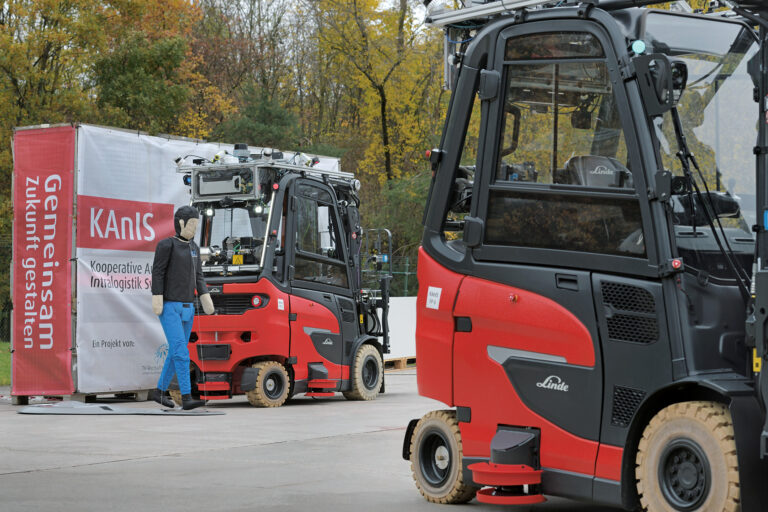Linde Material Handling (MH) and Aschaffenburg University of Applied Sciences (UAS) have unveiled the outcomes of their four-year research initiative, the KAnIS – Cooperative Autonomous Intralogistics Systems project, which aimed to explore the potential of cooperative behavior among autonomous intralogistics vehicles in improving operational reliability and handling performance.
The project was backed by a €2.8m (US$3m) grant from the Free State of Bavaria’s Information and Communication Technology R&D program, and the research results were presented at the Linde plant in Aschaffenburg on December 5.
The research tackled the challenges posed by the application of autonomous counterbalanced forklifts, designed for both indoor and outdoor load transportation. These forklifts demonstrated a cooperative exchange of real-time information via a 5G network and an edge server, facilitating obstacle warnings between vehicles. The research project comprised multiple subprojects addressing critical aspects such as vehicle location, regulation and control, forklift cooperation, load carrier recognition, weather impacts, predictive maintenance, route optimization and automatic load management.
Four Linde E20, E25 and E30 electric counterbalanced trucks, each with a load capacity ranging from 2.0 to 3.0 tons, were automated and equipped with electrohydraulic steering (Linde Steer Control), Linde Safety Pilot assistance system with an electronic load diagram, and an integrated fork positioner. The goal was not only to develop cutting-edge technologies but to practically implement these innovations. Mark Hanke, a head of department in pre-development at Linde MH, emphasized the importance of translating research results into tangible applications.
“For the university, the KAnIS project was a very complex, interdisciplinary research project. Ten professors and numerous research assistants and students were involved,” said Prof. Dr Hans-Georg Stark, project manager of KAnIS, and of the Faculty of Engineering at Aschaffenburg UAS, during the event. “Both project partners have benefited greatly from the intensive exchange between Aschaffenburg UAS’s scientific research activities and Linde MH’s many years of expertise in vehicle development.”
Moving forward, the automated forklifts are slated for further development and testing, focusing on specific material handling tasks. These tasks involve transporting wire mesh crates, pallets containing batteries and relocating vehicle frames and overhead guards. The latter two tasks require the forklifts to operate both indoors and outdoors, navigating gradients of up to 8% and encountering other automated guided vehicles (AGVs) and manually operated vehicles within halls.
To enhance reliability in handling diverse loads, the forklifts are equipped with a mobile camera between the forks that measures load carrier pockets, ensuring accurate fork positioning via side shift. Adjustments were also made to the vehicle frame, battery door and counterweight to accommodate these enhancements.
A critical aspect of the project focused on the forklifts’ perception of their surroundings. The vehicles were equipped with 3D scanners, HD cameras and personal protection system sensors to detect and classify objects. Cooperation among forklifts was crucial, especially in scenarios where concealed areas could not be detected by individual sensors. A private 5G network at the Aschaffenburg plant enabled real-time transmission of perception data among forklifts.
A notable test scenario involved a crash-test dummy unexpectedly appearing in the forklift’s path. Without cooperative behavior, the automated forklift couldn’t stop in time, resulting in a collision. However, with real-time information from a nearby forklift, the vehicle could anticipate and avoid the collision. In areas without nearby forklifts, stationary 3D laser scanners provided object detection information.
Additionally, the research addressed the challenge of maintaining near-ground optical sensors in adverse weather conditions. A system utilizing compressed air was developed to clean sensors contaminated by water splashes, ensuring continuous reliable object detection.
A separate project team explored autonomous charging solutions for forklift batteries, concluding in favor of an AI-based robot connecting the charging plug to the forklift’s charging socket. Modifications to the rear of the truck and an automatically operated charging flap were implemented to safeguard the charging socket from environmental elements.
“Autonomous vehicles will gradually take over more and more transport tasks,” said Stefan Prokosch, initiator of the KAnIS project at Linde MH. As a technology leader in the industry, the intralogistics specialist wants to make the benefits of autonomous vehicles available to customers who use counterbalanced forklifts to transport goods or load and unload heavy trucks.
“However, the requirements for forklifts operating in outdoor areas are much higher than those for purely indoor vehicles. These include the ability to operate on inclines and gradients, the presence of a significantly higher volume of people and traffic, and different weather influences and temperature conditions that need to be taken into account. Thanks to the joint research work with Aschaffenburg UAS, we have been able to develop viable solutions for these complex requirements.”


